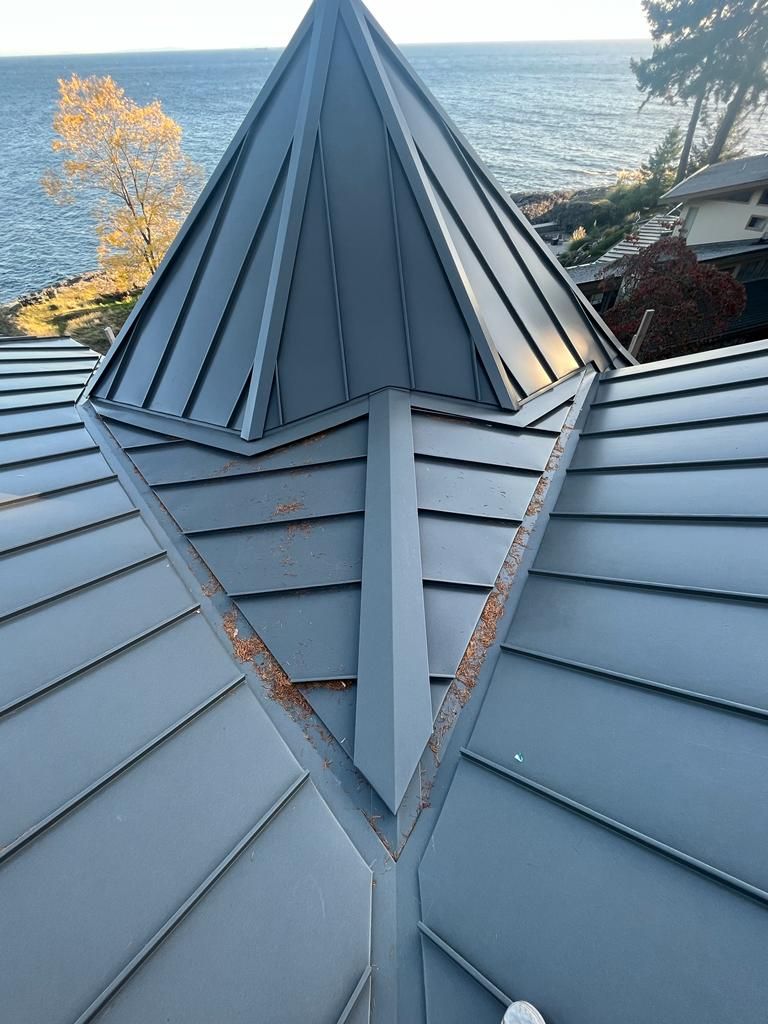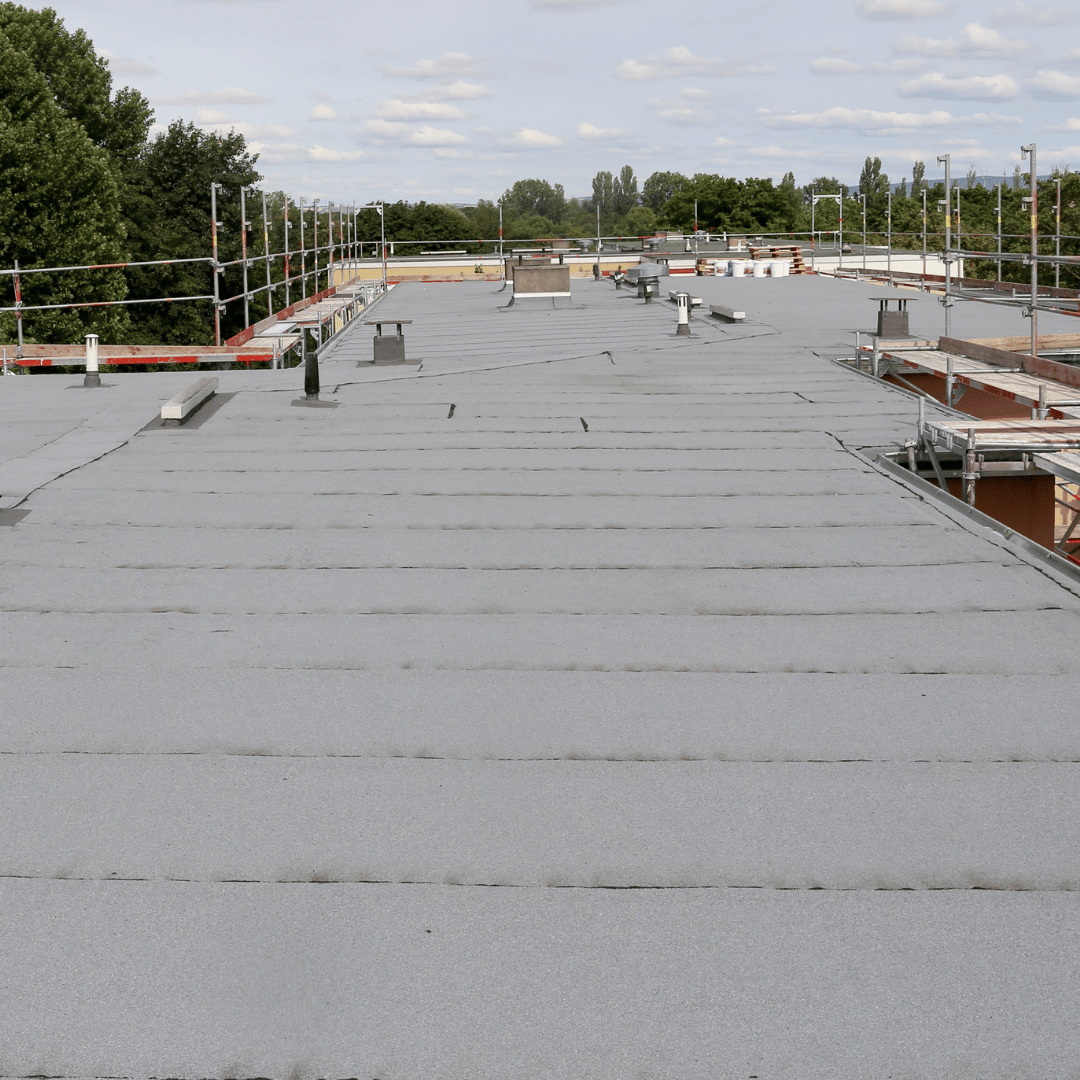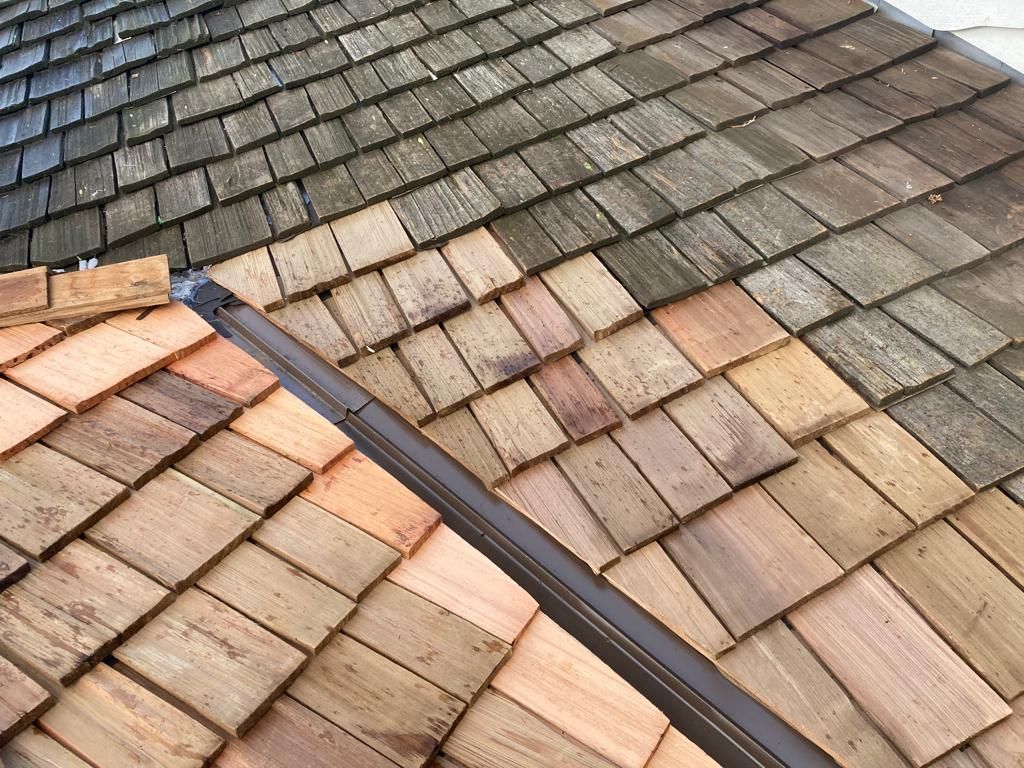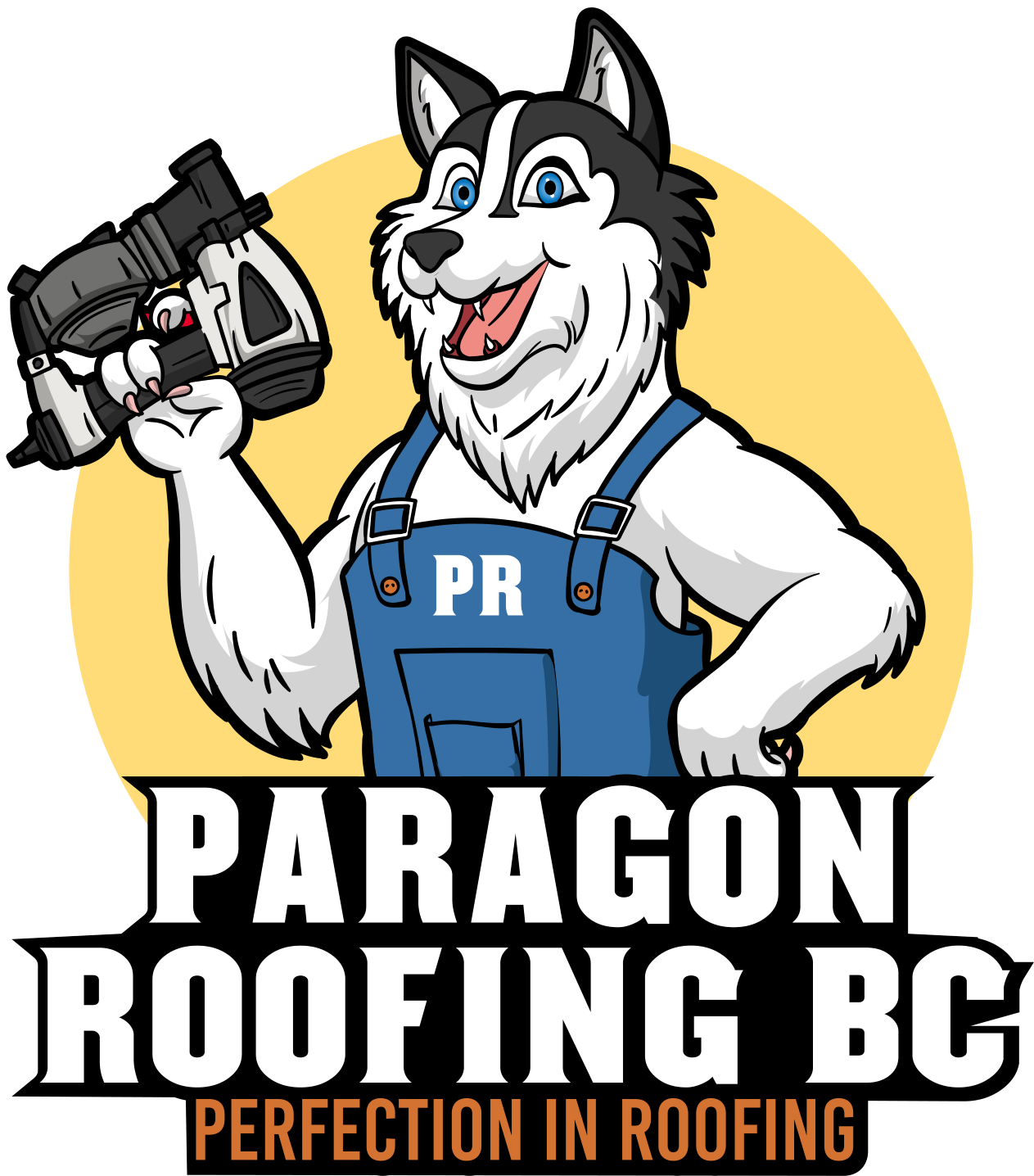Call Today
12233 92 Avenue, Surrey, British Columbia V3V 7R9, Canada
Reach Out
CALL US TODAY · 604-358-3436
Navigating Insurance and Claims on Vancouver Roofs
Struggling with a roofing insurance claim? Learn how to document damage, deal with adjusters, and maximize your payout with this Vancouver guide.
Alright, so your roof took a hit. Maybe it was one of those surprise windstorms that rip through the Lower Mainland when you least expect it, tearing shingles off like they were never even nailed down. Or maybe it's the classic Vancouver rain—relentless, sneaky, and somehow capable of finding that one weak spot in your roof that's been holding firm for years. Either way, you're staring at damage, possibly a leak, and now you're wondering, "How do I even start an insurance claim for this?"
First things first—don't panic. Seriously. Insurance can feel like a maze designed by someone who enjoys watching people struggle, but if you approach it correctly, you can get through it without pulling your hair out. The goal here is to ensure your insurance company helps you, which starts with giving them what they need in a way they can't ignore.
Before you even pick up the phone, start gathering information. You want to be their dream claimant—the person who makes their job easy because, trust me, the easier you make it for them, the faster things move. Take photos of everything. Wide shots, close-ups, different angles. If part of your roof is missing, get a picture of that. If water leaks inside, capture where it's coming in and any damage caused.
If you think, "Should I take a picture of this?" the answer is yes. And if you have any "before" pictures of your roof (maybe from when you first moved in or had it inspected), that's even better—those can help show the extent of the damage.
When you call your insurance provider, be ready to provide details, but keep it simple and factual. When did the damage happen? What caused it? What are the immediate effects? This isn't the time for storytelling—just the facts. If you're not sure exactly when it happened (because, let's be honest, you weren't sitting outside watching your roof every second), give your best estimate based on when you noticed the damage.
And here's a key thing: tell them right away if the damage is severe enough that it could get worse—like an active leak, missing shingles exposing the underlayment, or something that could cause more problems if left alone. Many insurance policies cover emergency repairs to prevent further damage before they even approve the entire claim. That means if water is pouring into your living room, you don't have to sit there with a bucket for weeks while waiting for paperwork to go through. Your policy might allow for a temporary fix, like a tarp or some immediate patchwork, so the damage doesn't spread.
But—and this is important—don't fully replace anything before they inspect it unless they specifically say you can. Otherwise, they might turn around and say, "Well, we didn't see the original damage, so we're not covering it." That's the last thing you need.
At the end of the day, the goal is to get your roof back in shape without unnecessary stress. It's frustrating—I get it—but take it step by step. The more organized you are, the smoother this will go. And if you ever feel like your insurance company is dragging its feet, don't be afraid to follow up—politely but firmly. You're not being a bother; you're just protecting your home.
And hey, if all else fails, at least you'll have some great photos to show off the time your roof decided to let the weather inside.
And remember, patience is key. Insurance companies aren't exactly known for their speed, and in Vancouver, after a significant storm, adjusters can get booked up fast. The sooner you get the ball rolling, the better.
Documenting roof damage for insurance isn't a thrilling Saturday activity, but doing it right can make the difference between getting your claim approved or getting the runaround from your insurance company. And the trick? Document everything. everything. If your roof sneezes, take a picture of the tissue.
Alright, here's what you need to do.
First up, photos—lots of them. You want wide shots of your entire roof, not just the problem areas. Stand back and capture different angles so it's clear how widespread the damage is. If you can get up safely (and I mean safely—don't be that guy who ends up in a viral "local homeowner vs. gravity" video), take pictures from a higher vantage point. If not, use a drone or a selfie stick—whatever works.
Now for the close-ups. This is where you zoom in on the details: missing shingles, lifted edges, cracked tiles, exposed underlayment, punctures, and anything that looks like it's been through a round with Mother Nature. If you see water pooling anywhere on a flat section, snap that too. Anything that looks off—photograph it. You can't have too many photos, but you can definitely have too few.
Speaking of water, don't forget the inside of your house. That slow drip from the ceiling? Yeah, it's not just an annoying stain—it's proof that water has made its way inside. Take pictures of any water stains, peeling paint, bubbling drywall, or mold. If you've got attic access, take a flashlight up there and look for damp insulation or rotting wood. The goal is to paint a clear picture of how the damage affects your home, inside and out.
Here's a big one most people forget: What caused the damage? If a tree branch decides to introduce itself to your roof, take photos of the debris. If it's still sitting there, leave it for the adjuster to see (unless it's a safety hazard). The same goes for any blown-off siding, detached gutters, or mystery shingles that aren't even yours (Surrey windstorms, am I right?). It all helps build a case that this wasn't just wear and tear but actual storm damage.
And timestamps—yes, timestamps. Most phones do this automatically, but double-check your settings to ensure it's enabled. If your insurance company starts asking, "When did this happen?" you want to be able to say, "Here's the exact date and time, and also, here's a photo of my dog looking unimpressed while I took it."
Here's something that can really save you: before photos. If your roof was in solid shape before the damage, having pre-storm pictures can shut down any arguments about "pre-existing conditions." I know—who goes around taking glamour shots of their roof? But if you recently had repairs or maintenance done, keep those invoices handy. A record of a recent repair or tune-up can prove that your roof was in good condition before the storm, making it harder for insurance to wiggle out of paying.
And finally, get a professional inspection report if you can. If a roofer (like us) takes a look and documents the damage in a written report, that adds even more credibility to your claim. Some adjusters don't have roofing expertise and might not recognize more subtle forms of damage, like lifted shingles or compromised underlayment. A professional's opinion can make all the difference when fighting for a fair payout.
Bottom line? More evidence = a stronger claim. If you ever need a second opinion, just shout—we've seen it all, from Delta windstorms to Vancouver rain trying to claim squatter's rights in your attic.
Understanding insurance coverage for storm damage can feel like trying to get through rush hour on Highway 1—frustrating, unpredictable, and sometimes, it just doesn't make sense. Not all storm damage is treated the same way, and the fine print in your policy matters a lot more than most people realize.
So, let's break it down in real terms.
Wind damage? That's usually covered—if it's significant. Now, what does "significant" even mean? Well, if a storm rips off half your shingles and sends your neighbor's patio furniture flying into your roof, that's one thing. But if you've just got a couple of lifted shingles? The insurance company might tell you, "That's just wear and tear, buddy," and leave you hanging. The trick here is knowing what your policy considers "damage worth covering." If you're unsure, have a roofer (like me or someone you trust) take a look before you file that claim—because once you do, it's on record whether it gets approved.
Rain damage gets a little murkier. If water made its way in because the storm damaged your roof, you're probably covered. But if your roof was already in rough shape—maybe missing a few shingles from that "windstorm" last year that you didn't fix—your insurance might argue that the damage was bound to happen anyway. That's where people get frustrated. You pay insurance to have your back in such situations, but they might turn around and say, "Sorry, this was a pre-existing issue." So, if you're reading this and thinking, "Oh crap, my roof is already kind of sketchy," maybe it's time to get it checked before the next storm rolls through. Prevention is cheaper than fighting an insurance claim.
Snow and ice damage? Less of an issue here in Vancouver, but not impossible. That could be covered if an ice dam forms on your roof and forces water to back up into your home. The catch? If your attic wasn't adequately insulated and ventilated, they might tell you it's your fault for not maintaining your home correctly. That's another fun insurance loophole—if they can blame it on "lack of maintenance," they will. A well-ventilated attic helps prevent ice dams, so if you've ever noticed weird temperature differences in your house or condensation in your attic, that might be a sign that it's time to check it out.
Falling trees or branches? This one is usually straightforward. If a storm knocks a tree onto your house, your insurance should cover it. But—and this is a big but—if the tree was already dead or rotting, and you never got around to dealing with it, they might deny your claim. So, if you've got a sketchy-looking tree in your yard that leans a little too much when the wind picks up, maybe don't wait until it's sitting in your living room before dealing with it.
Now, when it comes to working with Vancouver insurance adjusters, things can get a little… let's say, "complicated."
Insurance adjusters don't work for you. Their job is to evaluate the damage and decide how much (if anything) the insurance company will pay. It's a bit like trying to convince your landlord to return your damage deposit—if they can find a reason to give you less, they will.
The trick is to make their job easy while ensuring they don't overlook anything. If an adjuster is coming to inspect your roof, try to be there when they do. Better yet, have a roofer with you. Why? Because a roofer will actually advocate for you. An adjuster might look at something and say, "Oh, that's not storm damage; that's just old age," while a roofer can say, "Actually, this is directly from the storm, and here's why." Insurance companies are businesses, and businesses don't like to pay out money if they don't have to. A roofer who knows their stuff can ensure they don't lowball you or brush off damage that should be covered.
And if they do try to downplay it? Be polite but firm. If they say something isn't covered, ask them to show you exactly where your policy says that. Sometimes, just asking that question makes them reconsider. If they give you a lowball estimate that feels off, get a second opinion from a reputable roofing company. The more documentation you have, the better.
At the end of the day, dealing with storm damage and insurance claims isn't fun especially on Vancouver roofs. But the more you understand how it works, the less likely you are to get blindsided. And if you ever feel like you're getting the runaround, reach out to a professional who knows how to navigate the system. It's better to ask questions now than to get stuck with a hefty repair bill later.
It sucks, but insurance companies deny claims all the time, and half the time, it feels like they're just looking for a reason. They've got a playbook; if you don't know how to navigate it, you're the one left holding the bill. Let's break down some of the biggest reasons they reject claims so you can avoid getting caught in the mess.
- Pre-existing damage – This is a big one. If the insurance adjuster decides that your roof was already in rough shape before the storm, they'll toss your claim out faster than a Canucks fan after a bad call. It doesn't matter if that last windstorm ripped off half your shingles—if they think your roof was already weak, they'll say the damage wasn't sudden or unexpected. That's why it's wise to get regular roof inspections and keep some before-and-after photos handy. If you can show your roof was solid before the storm, it's way more complicated for them to argue otherwise.
- Lack of maintenance – I get it: roof maintenance isn't the most exciting way to spend your weekend. But here's the thing: insurance companies expect you to take care of your roof. If they see clogged gutters, moss taking over, or a bunch of cracked shingles that have been there for years, they'll blame you for "neglect." They figure that if you had maintained it correctly, the damage might not have been as bad or have happened at all. So even if you're not climbing up there, get someone to check it occasionally. Maintenance can be the difference between getting a full payout or nothing.
- Filing too late – This is brutal because many folks don't even realize a deadline. If your roof gets wrecked, you could take a second to breathe before dealing with the paperwork, right? Nope. Most policies have a strict time limit for filing claims, sometimes as short as a few weeks. Miss that window, and it's game over. So if something happens, don't wait—document the damage, call your insurer, and get the ball rolling. If you're unsure about your deadline, check your policy or call your insurance rep.
- Insufficient documentation – Imagine you're in a fender bender, but when you try to file a claim, you have no photos, witnesses, or police report. The insurance company will probably tell you to take a hike. Same deal with your roof. If you don't have clear proof that the damage was caused by a specific storm or event, they might say, "Sorry, we can't confirm that's covered." Taking pictures, saving receipts for emergency repairs, and even getting a roofer's inspection report can make a huge difference. The more proof you have, the harder it is for them to wiggle out of paying.
- Excluded perils – This is where insurance gets sneaky. Just because you have coverage doesn't mean you're covered for everything. Some policies exclude certain disasters—like earthquakes, floods, or even specific types of wind damage. You might think, "Well, I've got insurance, I'm good," but nope, not necessarily. That's why reading the fine print is key. If you live in an area that gets a lot of windstorms (hello, Delta and White Rock), you might need additional coverage. The worst time to find out your policy doesn't cover something is after your roof is already in your neighbor's yard.
At the end of the day, insurance companies aren't in the business of handing out money quickly. But if you stay on top of maintenance, document everything, and don't miss deadlines, you've got a much better shot at getting the payout you deserve. If you ever need help figuring out if your roof has damage or what to do next, just give a local roofer a shout—we always deal with this stuff.
Maximizing Your Roofing Insurance Claims
Dealing insurance is as fun as sitting on the Alex Fraser in rush hour. But if you're claiming roof damage, you don't want to rush it. Take your time, be thorough, and don't just take whatever number they throw at you. Here's what helps:
- Get multiple repair estimates – The insurance adjuster's first offer isn't always final. Their job is to save the insurance company money, not necessarily ensure you get the best deal. Having a few estimates from reputable roofers (not just the cheapest bid) gives you leverage to negotiate. If the numbers don't match up, ask why.
- Document everything —Every phone call, email, inspection report—keep it all. If they say they'll "get back to you," follow up. If they try to downplay the damage, have pictures ready, ideally from before and after the incident. Roofers like us often take before-and-after shots during maintenance or inspections, so if you've worked with someone in the past, they might have those for you.
- Don't be afraid to push back – If they deny your claim or lowball you, challenge it. Ask for their reasoning in writing and compare it to your policy. You'd be surprised how often they "reconsider" when you show them evidence.
- Public adjusters can help – If this becomes a headache, you can bring in a public adjuster. Unlike the insurance adjuster, they work for you, not the insurance company. They take a cut of the final payout, but in some cases, they can negotiate a way better deal than you'd get along. It might be worth it if you're looking at a big claim.
Insurance Requirements for Different Roofing Materials
Not all roofs are created equal in the eyes of your insurance provider. Some materials are cheaper to insure, some will hike your premiums, and some might even make it hard to get coverage.
- Metal roofing – This one's usually a win. It holds up better against wind, hail, and fires, so some insurance companies reward you with lower premiums. It's like getting a discount on car insurance for having a good driving record—except your "record" is just a solid roof that doesn't easily take damage.
- Cedar shake roofs – Beautiful? Absolutely. Insurance-friendly? Not so much. Cedar shakes are more vulnerable to fire and weather damage, which makes them more expensive to insure. Some companies even require proof of proper fire treatment. Insurers might also be concerned about long-term moisture issues if you're in an area like Surrey or Delta, where heavy rainfall is common.
Flat roofs are common in commercial buildings, but some residential homes have them, too. Insurance companies tend to be wary of these because water doesn't run off as easily, which means more potential for leaks, pooling, and eventual damage. If you have a flat roof, make sure your drainage system is top-notch and well-maintained—it might even help lower your rate.
Impact of Roof Condition on Insurance Premiums
Here's the deal: insurance companies like roofs that don't make them nervous. If your roof is in good shape, your premium will likely be lower. If it's older or showing signs of wear, expect them to adjust your rates accordingly.
- Age matters—Once your roof hits the 15—to 20-year mark, insurers start looking at it differently. Some companies won't even renew your policy if your roof is too old. If you're in Vancouver or Burnaby, where moss loves to grow on older roofs, it's worth getting a professional cleaning and inspection to show your roof is still solid.
- Regular maintenance saves money – Think of it like your car—if you keep up with oil changes and repairs, it runs longer and costs less in the long run. Same with your roof. If an insurer sees you've had inspections, minor repairs, and cleanings done over the years, they're less likely to hike your premium.
- Some insurers require inspections – If you're getting a new policy or renewing an old one, don't be surprised if they ask for a roof inspection. They want to know what they're insuring. Suppose your roof has a few questionable areas but isn't in terrible shape, getting a professional roofer to do a preemptive inspection might help—this way. In that case, you can fix minor issues before they become big ones that impact your rates.
Insurance Policies for Commercial Roofing
Commercial roofing insurance is a whole different game. If you own a business property, you have more to consider than just the roof itself.
- Flat roofs need extra coverage – Many commercial buildings have flat roofs, and insurers know they're prone to pooling water, which can lead to leaks, mold, and interior damage. If your roof doesn't have proper drainage, you might be looking at higher premiums or exclusions for water-related damage.
- Check for structural and interior damage coverage – If your roof leaks and ruins thousands of dollars of inventory inside your building, will your policy cover it? Some policies only cover the roof itself, not the damage it causes. Double-check this before assuming you're fully covered.
- Know your policy limits – Some commercial property owners find out the hard way that their policy has a depreciation clause, meaning they don't get the full replacement cost of a damaged roof, just a fraction of it based on the roof's age. If you're in a high-rainfall area like Coquitlam or North Vancouver, where constant moisture can age a roof faster, this is worth looking into.
Dealing with insurance can be frustrating, but knowing the ins and outs of your policy and staying on top of your roof's condition can make all the difference. And if you ever feel like they're giving you the runaround, remember: they work for the insurance company, not for you. So, advocate for yourself, keep records, and don't be afraid to push back when needed.
Comparing roofing insurance providers in Vancouver
Let's be honest—insurance companies can be a mixed bag. Some are fantastic, quick to respond, and genuinely there when you need them. Others? Well, they'll have you on hold for an hour only to tell you that your claim is missing a form you've never heard of. Then some find creative ways to deny claims—like blaming a leak on "improper maintenance" even though you have a spotless roof.
So, how do you pick the right one? First, don't just go for the cheapest policy. A low premium is significant until you need to file a claim, and suddenly, you're dealing with loopholes, fine print, and adjusters who act like they're doing you a favor by returning your call. Instead, look for providers with a solid reputation—ask around, read online reviews, and maybe even chat with a few roofers. We deal with these companies constantly and have a pretty good sense of which ones play fair and which will give you a headache.
Another thing to check is what exactly the policy covers. Some policies only cover damage from specific causes, like wind or hail, but leave out things like gradual wear and tear, which—let's be honest—is a big deal in a place like Vancouver where the rain never really takes a break. If your insurance doesn't cover leaks caused by long-term exposure to moisture, you might be out of luck when that slow drip turns into a full-blown ceiling collapse.
And for anyone in the Lower Mainland, especially places like Surrey, Delta, or Burnaby, where trees are everywhere, double-check if falling branches are covered. It's a real problem here. One good windstorm, and suddenly, your neighbor's cedar is taking a nap on your roof. Some policies cover that without a fuss; others will make you prove that the tree was healthy beforehand as if you had an arborist on retainer.
Final thoughts
Roofing insurance claims can be a pain; there is no way around it. But if you stay ahead of the game—keeping your roof in good shape, documenting everything, and ensuring your policy covers what you think it does—you can avoid stress. And don't let an insurance company push you around. If they deny your claim for something that should be covered, push back. They count on people giving up and accepting the first "no." A little persistence goes a long way.
And hey, if you ever need a second opinion on your roof before you file a claim, don't hesitate to contact me or another reputable roofer. We see this stuff every day and are happy to give you a straight answer. No fluff, no nonsense—just ensuring you don't get taken for a ride.
Stay dry Vancouver,
Harman
How do I start a roofing insurance claim after a storm?
First things first, don’t wait—insurance companies have strict deadlines for filing claims. Your best move is to document everything immediately.
Take photos and videos from multiple angles—your whole roof, the damage up close, any missing shingles, and even the interior if there’s a leak.
If you have “before” photos from previous maintenance, those help prove the storm is the culprit, not “pre-existing conditions” (a term insurance companies love).
Write down a timeline of when the damage happened (or when you noticed it). If you didn’t see it immediately, estimate based on recent weather events.
Call your insurer and describe the damage clearly. Stick to facts—no need for dramatic storytelling. Mention if further damage is likely to happen (like an active leak), as many policies cover emergency repairs before the full claim is approved.
And do not start major repairs before an adjuster inspects the damage unless your insurer gives you the green light. Otherwise, they might say, “Well, we didn’t see it, so we’re not covering it.” That’s not a fun conversation to have.
What should I document when my roof is damaged?
Think of it like this—if you ever find yourself wondering, “Should I take a photo of this?” the answer is yes. Insurance companies don’t like ambiguity, so the more evidence you have, the better.
Photos, lots of them. Wide shots, close-ups, different angles. If shingles are missing, if a tree branch is lounging on your roof, or if water is creeping into your ceiling—capture all of it.
Interior damage. Water stains on your ceiling? Peeling paint? Bubbling drywall? That’s proof water got in—document it.
Attic inspection. If you can, take a flashlight up there and check for damp insulation, mold, or water damage.
The cause of the damage. If wind knocked over a tree onto your house, photograph the tree. If your gutters got ripped off in a storm, document the aftermath.
Timestamps matter. Your phone does this automatically, but check to ensure the setting is enabled. If your insurance company questions when the damage occurred, you’ll have proof.
Receipts for past maintenance. If your roof was in good shape before the storm, records of inspections or repairs can help fight any “pre-existing damage” arguments.
Can I make temporary repairs while waiting for my insurance claim?
Yes, but only for emergency fixes that prevent further damage. A small leak today can turn into a soggy nightmare if left alone, and most policies cover these immediate repairs.
However:
Keep all receipts and invoices from emergency repairs—your insurer should reimburse you.
Don’t fully replace anything until the adjuster has inspected it. If you replace your entire roof before your claim is approved, they might refuse to pay, arguing they didn’t get to see the “real” damage.
So, if water is getting in, a professional roofer can apply a temporary patch or tarp. Just don’t try to DIY anything risky—no insurance payout is worth a trip to the ER.
What types of storm damage does insurance cover?
It depends on your policy, but most cover:
✅ Wind damage (if shingles were torn off, tree branches fell on your roof, etc.)
✅ Rain damage (if the storm compromised your roof and water got in)
✅ Snow/ice damage (if ice dams formed and forced water back inside)
✅ Fallen trees (as long as the tree wasn’t already dead and neglected)
What types of storm damage, insurance does not cover?
What they might not cover:
❌ “Gradual” water damage. If they decide your roof was already vulnerable and just finally gave up, they’ll call it “wear and tear” and deny the claim.
❌ Lack of maintenance. If your roof was already in rough shape (moss-covered, cracked, clogged gutters, missing shingles from last year), they might argue you should have fixed it earlier.
❌ Excluded disasters. Not every policy covers floods or earthquakes—check your fine print.
Will my insurance company try to lowball me?
Their job is to save the insurance company money. That doesn’t mean they’re out to get you, but they will often offer the lowest reasonable payout.
Here’s how to avoid getting shortchanged:
Get multiple estimates from reputable roofers. If their payout is significantly lower than repair quotes, push back.
Have a roofer present when the adjuster inspects your roof. Adjusters aren’t roofing experts, and some damage (like lifted shingles) isn’t always obvious to them. A roofer can advocate for you.
Ask questions. If they deny something, request a written explanation. If the payout seems off, ask how they calculated it. Sometimes just questioning their decision makes them reconsider.
Can I dispute an insurance claim denial?
Yes, and you absolutely should if you believe the denial was unfair.
Steps to fight back:
Get their reasoning in writing. Insurance companies love vague answers. Make them put it on paper.
Compare it to your policy. If they claim something isn’t covered, check your policy wording—sometimes they rely on people not reading the fine print.
Bring in a public adjuster. Unlike the insurance company’s adjuster, a public adjuster works for you. They can negotiate on your behalf for a better payout.
Consider a second opinion. A roofing inspection from a trusted professional can add credibility to your case.
Do different roofing materials affect insurance coverage?
Yes, and your insurance provider definitely has preferences.
Metal roofing – Great for lower premiums because it resists wind, fire, and hail damage.
Cedar shake roofs – Beautiful but higher risk. Fire concerns and potential for water damage mean higher insurance costs.
Flat roofs – Common for commercial properties, but prone to pooling water, so some insurers require extra coverage.
Older roofs often result in higher premiums or even policy restrictions. If yours is 15-20+ years old, some insurers may require an inspection before renewing your coverage.
How can I keep my insurance premiums low while still being covered?
A few smart moves can help:
✔ Keep up with maintenance. Insurers love well-maintained roofs—clean gutters, replace damaged shingles, and get regular inspections.
✔ Choose impact-resistant materials. If you’re replacing your roof, materials like metal or certain composite shingles may qualify you for lower rates.
✔ Prove your roof is in good shape. If an insurer questions your roof’s condition, showing recent maintenance records can keep your premiums from increasing.
What’s the biggest mistake homeowners make when filing a claim?
Waiting too long. Most policies have deadlines—sometimes as short as a few weeks after the damage occurs. If you delay, you might miss your chance to get coverage.
The second biggest mistake? Not having enough documentation. A blurry photo of your ceiling stain isn’t going to cut it. Insurance companies want undeniable proof that your roof was damaged by a specific event and wasn’t already falling apart.
Is it worth getting a professional inspection before filing a claim?
Absolutely. A roofing expert can:
Identify storm damage the adjuster might overlook.
Provide a report that strengthens your claim.
Help prevent unnecessary denials by confirming what’s actual storm damage vs. normal wear and tear.
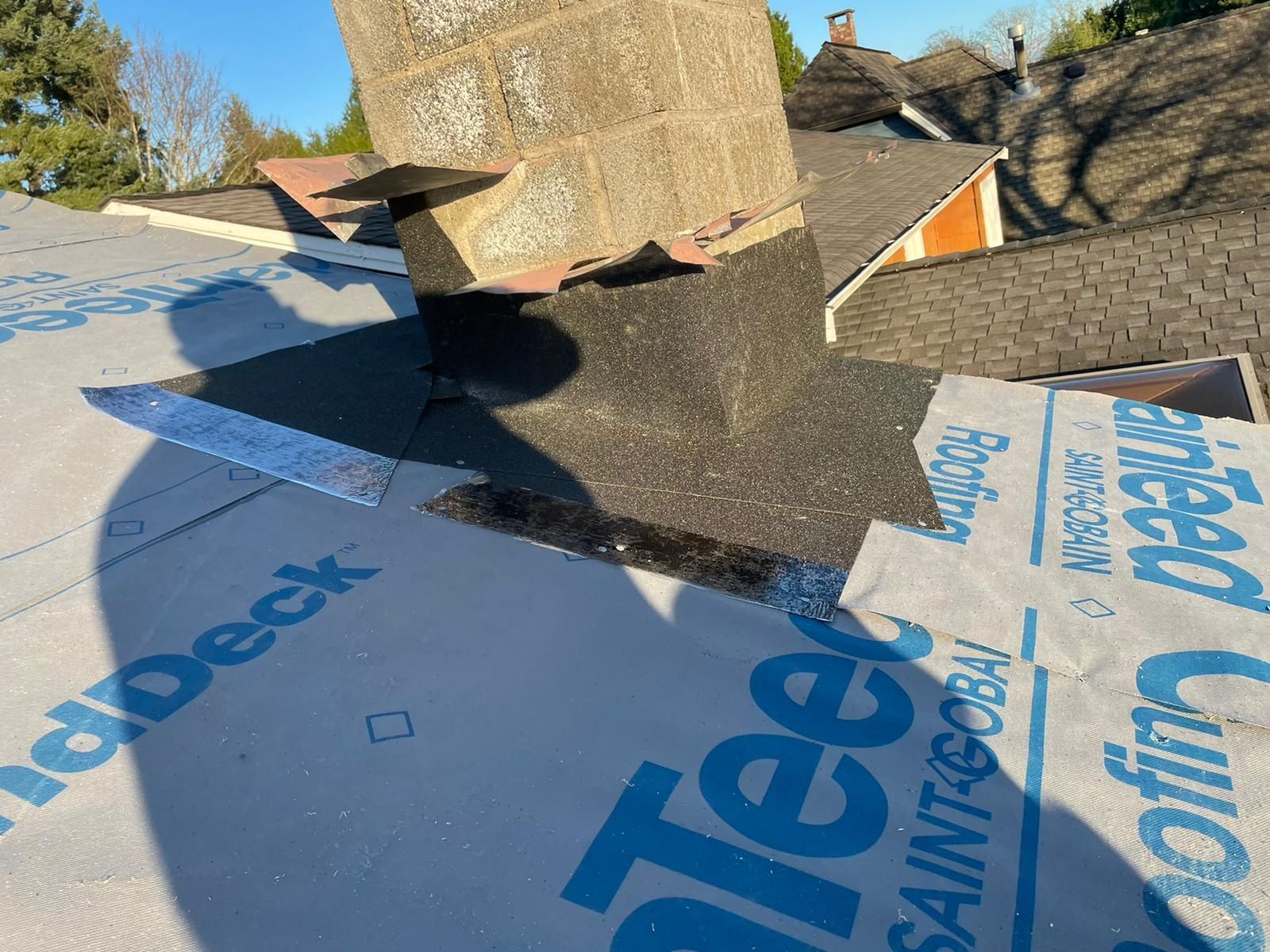
Our Roofing Blog
Have more questions about roofing?
Check out our FAQs or give us a call today to speak to an expert roofer in Vancouver Lower Mainland, BC. We're here to help our neighbours make educated decisions about their roof. For our team, we value helping clients save money while making their roofs last.
All Rights Reserved | Paragon Roofing BC | Web Design & SEO by Piiper Digital Solutions

